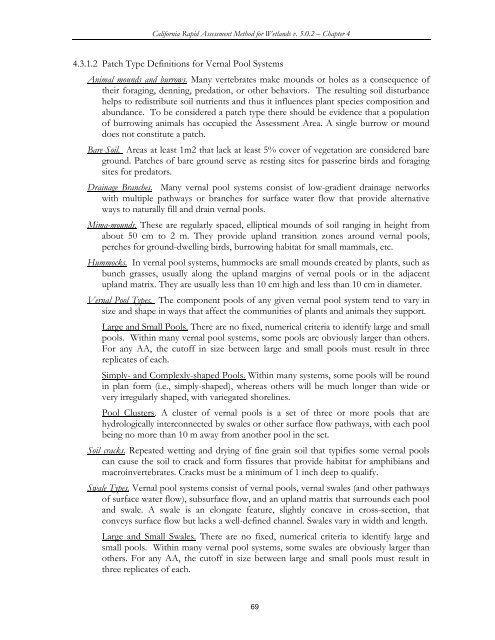(CRAM) For Wetlands User's Manual Version 5.0.2
(CRAM) For Wetlands User's Manual Version 5.0.2
(CRAM) For Wetlands User's Manual Version 5.0.2
Create successful ePaper yourself
Turn your PDF publications into a flip-book with our unique Google optimized e-Paper software.
California Rapid Assessment Method for <strong>Wetlands</strong> v. <strong>5.0.2</strong> – Chapter 4<br />
4.3.1.2 Patch Type Definitions for Vernal Pool Systems<br />
Animal mounds and burrows. Many vertebrates make mounds or holes as a consequence of<br />
their foraging, denning, predation, or other behaviors. The resulting soil disturbance<br />
helps to redistribute soil nutrients and thus it influences plant species composition and<br />
abundance. To be considered a patch type there should be evidence that a population<br />
of burrowing animals has occupied the Assessment Area. A single burrow or mound<br />
does not constitute a patch.<br />
Bare Soil. Areas at least 1m2 that lack at least 5% cover of vegetation are considered bare<br />
ground. Patches of bare ground serve as resting sites for passerine birds and foraging<br />
sites for predators.<br />
Drainage Branches. Many vernal pool systems consist of low-gradient drainage networks<br />
with multiple pathways or branches for surface water flow that provide alternative<br />
ways to naturally fill and drain vernal pools.<br />
Mima-mounds. These are regularly spaced, elliptical mounds of soil ranging in height from<br />
about 50 cm to 2 m. They provide upland transition zones around vernal pools,<br />
perches for ground-dwelling birds, burrowing habitat for small mammals, etc.<br />
Hummocks. In vernal pool systems, hummocks are small mounds created by plants, such as<br />
bunch grasses, usually along the upland margins of vernal pools or in the adjacent<br />
upland matrix. They are usually less than 10 cm high and less than 10 cm in diameter.<br />
Vernal Pool Types. The component pools of any given vernal pool system tend to vary in<br />
size and shape in ways that affect the communities of plants and animals they support.<br />
Large and Small Pools. There are no fixed, numerical criteria to identify large and small<br />
pools. Within many vernal pool systems, some pools are obviously larger than others.<br />
<strong>For</strong> any AA, the cutoff in size between large and small pools must result in three<br />
replicates of each.<br />
Simply- and Complexly-shaped Pools. Within many systems, some pools will be round<br />
in plan form (i.e., simply-shaped), whereas others will be much longer than wide or<br />
very irregularly shaped, with variegated shorelines.<br />
Pool Clusters. A cluster of vernal pools is a set of three or more pools that are<br />
hydrologically interconnected by swales or other surface flow pathways, with each pool<br />
being no more than 10 m away from another pool in the set.<br />
Soil cracks. Repeated wetting and drying of fine grain soil that typifies some vernal pools<br />
can cause the soil to crack and form fissures that provide habitat for amphibians and<br />
macroinvertebrates. Cracks must be a minimum of 1 inch deep to qualify.<br />
Swale Types. Vernal pool systems consist of vernal pools, vernal swales (and other pathways<br />
of surface water flow), subsurface flow, and an upland matrix that surrounds each pool<br />
and swale. A swale is an elongate feature, slightly concave in cross-section, that<br />
conveys surface flow but lacks a well-defined channel. Swales vary in width and length.<br />
Large and Small Swales. There are no fixed, numerical criteria to identify large and<br />
small pools. Within many vernal pool systems, some swales are obviously larger than<br />
others. <strong>For</strong> any AA, the cutoff in size between large and small pools must result in<br />
three replicates of each.<br />
69















